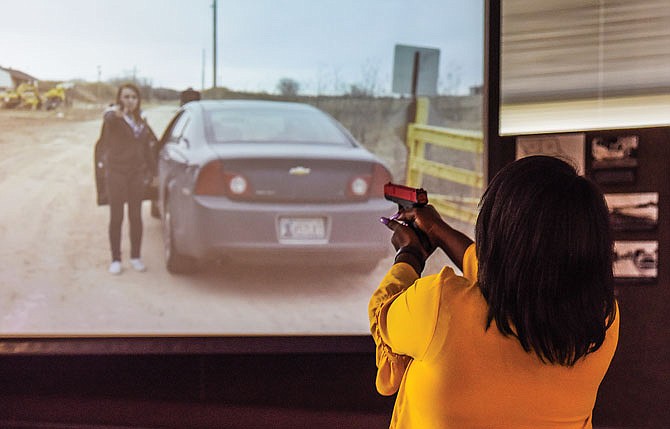Reporters from around the state got a look Friday at how the Missouri Highway Patrol trains for some of the situations troopers face every day.
Command staff at the Highway Patrol's General Headquarters in Jefferson City took reporters through an accountability forum the patrol has conducted for legislators, community leaders and clergy across the state.
"We started putting this together this summer as the pandemic was continuing and more cases of civil unrest were occurring," Highway Patrol Col. Eric Olson said. "This was a way to show how and why we do our job in certain situations. We don't want to be complacent because complacency can be detrimental to a law enforcement agency."
Gov. Mike Parson stopped by briefly and said he hopes these type of events will be done by other law enforcement agencies in the state. A former sheriff, Parson said he believes law enforcement needs to prioritize community policing activities to interact with citizens in a positive way.
"The general public needs to know more about what officers do and how they are trained," Parson said. "We have to be more transparent as law enforcement officers on everything we do in today's time."
Patrol Sgt. Aaron Griffin told reporters they haven't changed how they do training to de-escalate situations in light of recent events.
"De-escalation is not just a block of training that we go through with our recruits and when they're done, check a box and say, 'OK, you've got it,'" Griffin said. "We think it should be done through the entire six-month training process. The first thing we focus on is how we treat people. De-escalation is as simple as having a conversation with a person instead of yelling at them."
People are more willing to do something you want them to do if you treat them with respect, Griffin said.
Story continues below video
"We continue to have the expectation of our officers to be respectful and open when dealing with the public," Griffin said. "We tell them that if they see a law officer using excessive force, it is their duty to stop it and tell their supervisors."
Griffin was specifically asked if the patrol teaches what some call the "chokehold" technique to subdue a suspect.
"We do not allow chokeholds because it restricts a person's airflow," Griffin said. "We teach vascular neck restraints, which can restrict blood flow and render a person unconscious before sustaining any injury. VNR safely subdues a violent subject that is resisting an officer."
Patrol Capt. John Hotz noted they used this tactic 21 times in 2019, and there were no reports of significant injuries.
Part of Friday's event included taking reporters through scenarios such as how recruits train for a traffic stop. Cpl. Andrew Armstrong led the demonstration and noted patrol trainees are taught attention to detail and critical thinking because often they have only a few seconds to assess and react to a situation.
"Recruits go through 40 hours of traffic stop training at the academy, and when they get out they do 18 weeks where they are evaluated on what they do on stops by a trainer," Armstrong said. "We want them to use their tactical verbal skills to help de-escalate a situation. We use road troopers as role players who go through scenarios they've been through on the road to teach the trainees."
Story continues below video
If he were following a vehicle he was possibly going to stop, Armstrong said, he would first evaluate the movement and actions of the vehicle's occupants, even before turning on his emergency lights.
"After I stop them, I clear the trunk area, putting my fingerprints on there to give some evidence that I was in contact with the vehicle," Armstrong said. "We want to make sure it's secure as well. We then look in the back seat area and all the while still have an eye on the driver and perhaps a passenger to check their movements."
Armstrong said they teach recruits to always introduce themselves to whomever they've stopped and give the reason for the stop.
"The majority of the time, the responses we get are, 'I'm sorry, officer, let's get this taken care of,'" Armstrong said. "However, you don't know that going in, so we have to be aware of what is happening. I'm making sure they can't do anything to harm me.
"The bottom line is, I want the recruits to treat a person they stop the way I would want a member of my family to be treated," he said.

